Forget the ‘fake’ BBQ. These are the dishes every Mongolia visitor needs to try, according to locals
Editor’s Note: This CNN Travel series is, or was, sponsored by the country it highlights. CNN retains full editorial control over subject matter, reporting and frequency of the articles and videos within the sponsorship, in compliance with our policy.
Mongolian cuisine can best be summed up by a local proverb: “Give a man a knife, fire and some stones, and he has a kitchen.”
Home to one of the world’s most famous nomadic cultures, Mongolia’s food reflects the nation’s resourcefulness and its deep-rooted relationship with nature.
It’s also a cuisine that is highly misunderstood, thanks to the many deceptive, so-called “Mongolian barbecue” restaurants in cities around the world.
“They’re all fake,” says Javkha Ara. “Very different from the original Mongolian foods.”
A filmmaker and a self-proclaimed “mad foodie” from the northern city of Darkhan, Ara founded Artger (combining the words art and ger, which means yurt) in 2016 after he realized how little information about his country was available online.
Artger’s YouTube channel, which has amassed more than 510,000 subscribers and millions of views, focuses on Mongolian cuisine and culture. The channel’s English-language shows offer a glimpse into different facets of Mongolia, such as families preparing breakfast in a yurt, two friends enjoying some barbecue in the countryside, or Mongolian wrestlers chowing down on hundreds of dumplings.
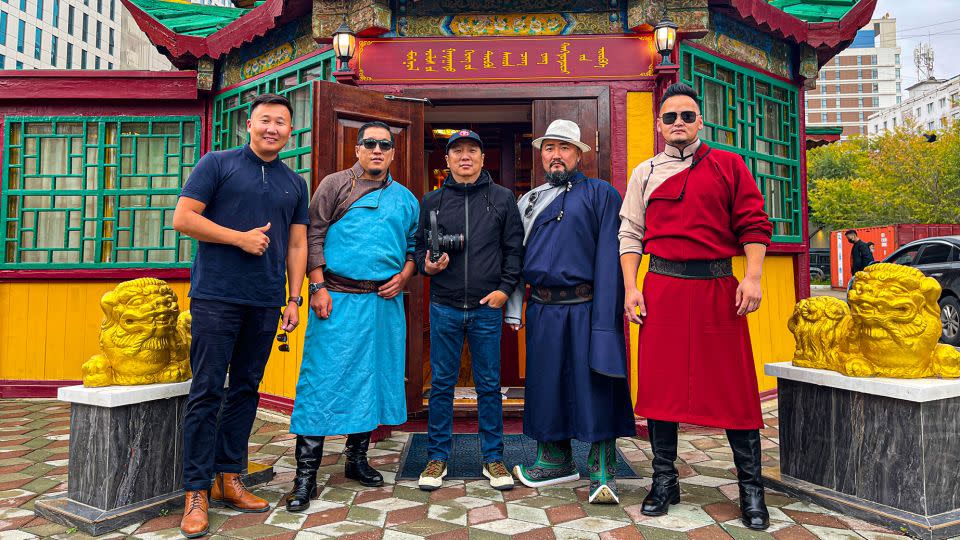
Secrets of Mongolian cuisine
“Mongolian food is like a secret to the Western world,” says Ara. “It’s unique because many Mongolian foods rise from our nomadic culture.
“People just assume we’re crazy meat-eaters. It’s partly true – but also a little wrong. Mongols eat meat in winter because the winters are harsh. But when summertime comes, we eat dairy products like milk, and we have many wild greens. It’s balancing.”
Munkhtsetseg Nasanbat, head chef at the Three Camel Lodge, a luxury ger camp in Mongolia’s Gobi Desert, offers similar sentiments, noting that the country’s varied terrain has a big influence on taste.
“Mongolian cuisine is diverse, encompassing not only meat but also a wide range of dairy products, berries, fruits and meat products from various regions,” she says.
“The taste of dairy products and meat can differ significantly between provinces, influenced by the type of grass that livestock graze on. For instance, meat from the Gobi region has a distinct taste with hints of wild garlic, while meat from the steppe areas is known for its rich wild onion flavor.”
These nuances are important as many Mongolian dishes contain just three basic elements: meat, wheat and salt. Spices and sauces don’t play a big part. This might give the impression that Mongolian food is a monotonous affair, but these simple ingredients can produce a wide range of flavors thanks to the varied cooking techniques used in different regions of Mongolia.
“If you take a grand tour around Mongolia, you’ll see the north uses more smoking techniques as it is better to keep food for longer in cold weather, but there are many more boiled dishes in the south,” says Batsuuri Gantulga, sales manager and itinerary designer for Goyo Travel, a tour operator based in Mongolia’s capital city, Ulaanbaatar.
“Much of our meat comes from the countryside. They’re grass-fed in the countryside and not from the factory. So different regions may use different meat available near them.”
For example, there are more camels in the south, while reindeer are primarily found in the north.
“You will find smoked fish dishes in the north as well,” adds Gantulga.
Appetite whetted? Here are 10 Mongolian dishes that will offer a well-rounded taste of the nation’s cuisine when you visit, according to the locals.
Boodog
If a Mongolian family prepares a boodog for you, you know you’re special.
Requiring a lot of time and effort to master, it’s prepared using techniques and skills that have been passed down through generations.
“It’s the (culinary) namecard of Mongolia,” says Ara, who even has a show on his YouTube channel called “Boodog Boys.”
First, the boodog master carefully removes the offal, meat and bones from the animal – usually a goat – while leaving the skin intact. Then, the meat is carefully cleaned and seasoned. Smooth river stones are collected and fired till they are blazing hot.
After hours of prep work, the master starts adding layers of hot stones, meat, bones and vegetables (usually potatoes, carrots and onions) inside the animal skin.
The skin is then sewn shut – in the old days, they used horse hair – and grilled above a fire, with the chef occasionally rotating it slightly as it cooks.
The hot stones help stew the fillings from within, while the barbecue fire – with the help of a blowtorch – roasts the exterior of the boodog.
“It’s historically a dish for warriors,” says Gantulga. “It makes more sense to cook using the skin of the animals than bringing pots and washing dishes on a campaign.”
After a few hours of cooking, family and guests gather around the barbecue to cut open the boodog and enjoy the feast.
Khorkhog
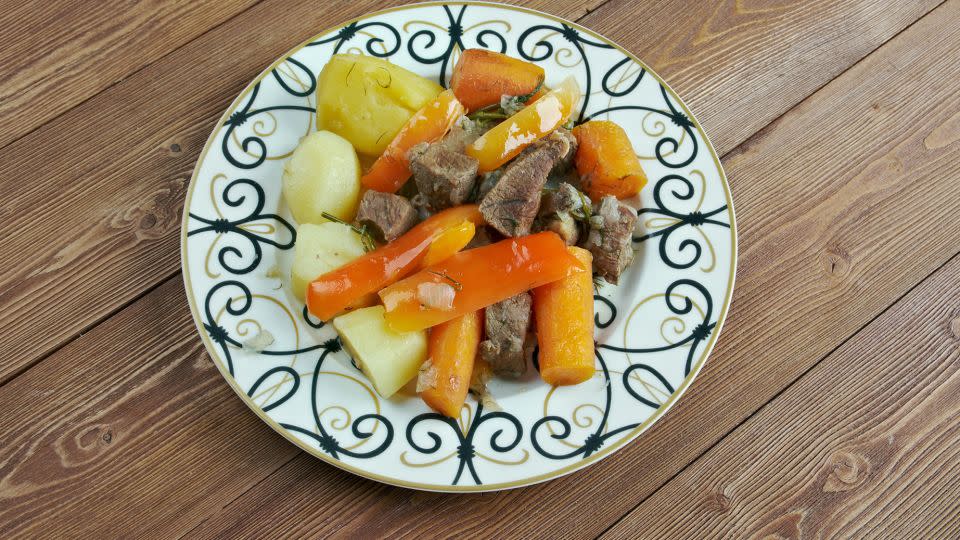
A modern version of boodog, khorkdog shares the same ingredients as the classic Mongolian meal. But instead of using the skin of the animal, it’s cooked in a pressure cooker or a traditional metal milk jug.
In summer, families set up fires in the countryside to barbecue on and these pots of khorkhog are often the star of the party.
Although it requires less prep time than a traditional boodog, making khorkhog is still a time-consuming feat, not to mention slightly dangerous.
“With the hot stones and meat inside the sealed metal jug, you also need to know when to roll the pot around to relieve some of the pressure that’s built up during the cooking process, or it may explode,” says Gantulga.
Buuz
The bigger, meatier, oilier cousin of Chinese steamed dumplings, buuz were traditionally eaten during Tsagaan Sar, the Mongolian Lunar New Year, but are now also a popular fast-food treat enjoyed all year.
During Tsagaan Sar, everyone joins in to help knead the dough and roll dumpling wrappers. The meat – often lamb and beef – is minced, pounded and mixed with salt.
Hundreds of buuz are made in one go and then left outside on trays to freeze.
“Every family has its own recipe,” says Gantulga. “Some modern families add cabbages and carrots and some even add rice into their buuz.”
The dumplings are steamed and usually eaten without dipping sauces.
A smaller version of these dumplings, bansh, are sometimes added to hot Mongolian milk tea, which is made with cow milk, tea leaves and sheep tail fat. Called banshtai tsai (Mongolian tea dumplings), they’re a nice treat on cold nights.
Khuushuur
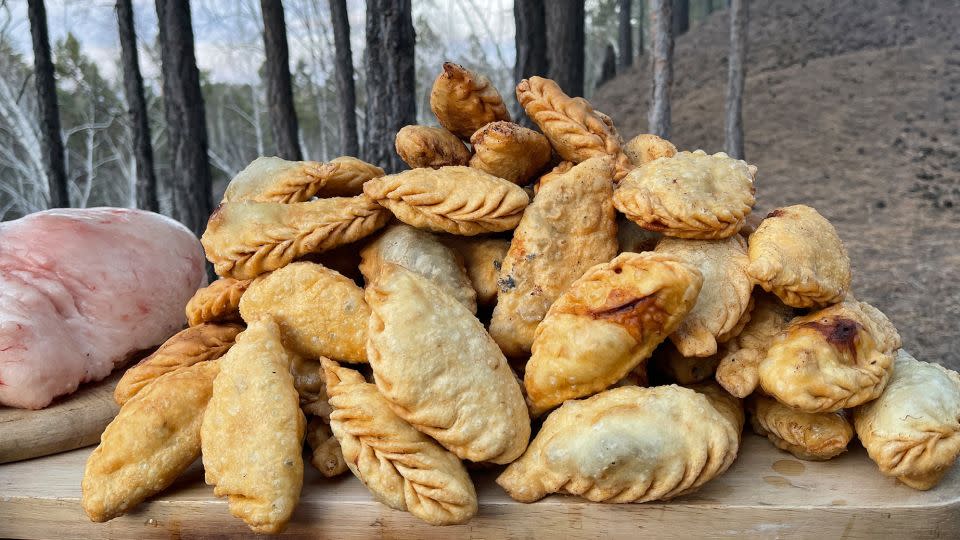
Khuushuur, deep-fried dumplings, are often jam-packed with meat fillings and wrapped in a half-crescent shape.
“Like an empanada,” Gantulga says.
The deep-fried meat pockets are the unofficial snack of the annual Naadam Festival.
The Naadam version is made differently – the traditional khuushuur is flattened with a rolling pin, so the fillings and the dough will be roughly blended into a thin disc then deep-fried.
The outcome is a treat that looks more like a golden-brown, crispy meat cookie than a dumpling.
Borts
“People ask how did the Mongolian empire get so strong, traveling thousands of kilometers from Mongolia to Baghdad or Russia – the magic is the borts,” says Ara.
Borts are dried meat strips made in the traditional nomadic way. It’s believed that when Genghis Khan grew his empire, these Mongolian jerky strips helped feed and nourish the soldiers on their long expeditions.
The type of meat used depends on the region of Mongolia but beef and goat are the most common options.
The meat, prepared in the winter, is sliced into thin, long strips before it’s air-dried and cooled, both indoors and outdoors. The strips are then preserved and consumed in the summer.
Borts are often broken into smaller pieces and added to water and salt to make soup. They’re included in many Mongolian dishes as well, from tsuivan (fried noodles) to banshtai tsai (tea dumplings).
Tsuivan
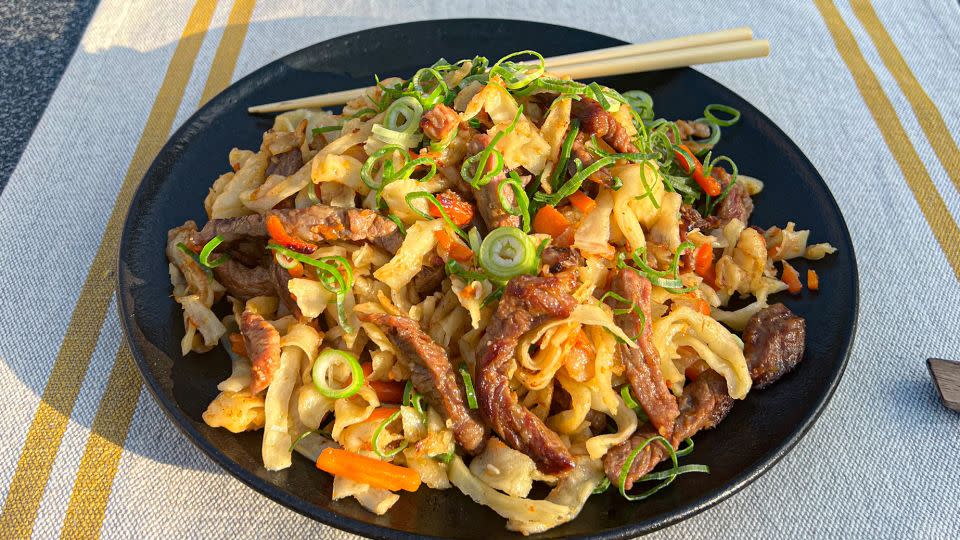
Tsuivan – stir-fried meat and vegetables with noodles – is one of Mongolia’s most-loved dishes.
First, meat and vegetables are chopped and stir-fried with sheep tail oil and salt.
Then, noodles – hand-cut ones are best – are added to the top of the sizzling ingredients with some water.
The resulting steam softens the noodles, and the water is eventually absorbed by the meat and the noodles.
“Families often prepare their own versions of tsuivan but mixing it with milk tea is a delightful twist,” says Three Camels Lodge chef Nasanbat. She also adds salted ramsons, a plant that grows in Gobi, to enhance the flavors.
Bituu shul
Nothing warms a Mongolian’s heart like a homey bowl of bituu shul.
This mutton soup is considered the ultimate comfort food. It’s a sickness remedy as well as a hangover stew.
It’s made by layering a bowl with chopped mutton, slices of sheep tail fat, salt and water. The bowl is then tightly sealed with a sheet – or sheets – of dough before it’s steamed or baked.
When the soup is cooked thoroughly, carefully break open the blanket of bread on top. Breathe in the steaming fragrance coming from the bowl through your nose before taking your first bite of the soup.
“When you’re tired – say after a long trip – or stressed, you can eat this soup. Then, you’re relaxed,” says Gantulga.
Boortsog
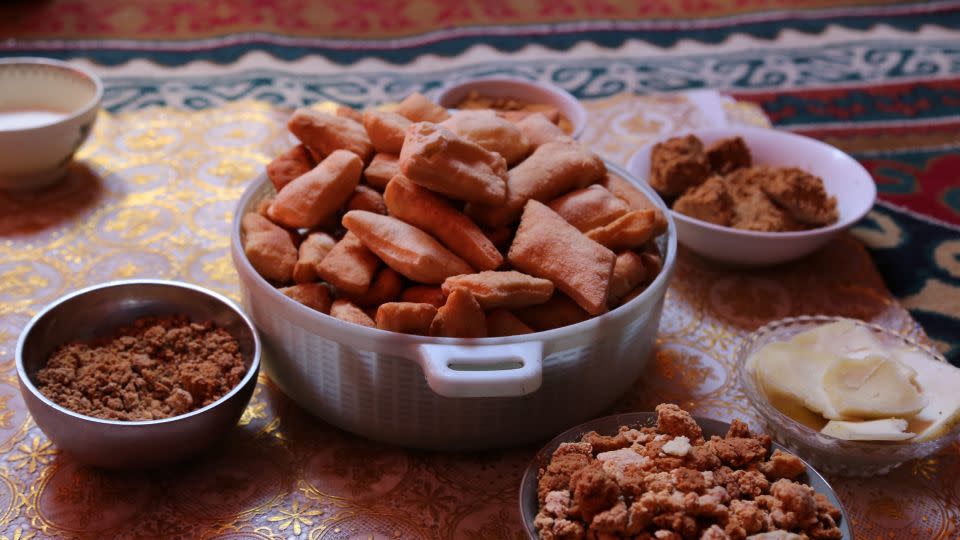
Visit any Mongolian family and you are likely to see a small mountain of boortsog on a plate.
Boortsog is considered Mongolia’s national cookie. Every family has a different recipe and will twist their boortsog into different shapes, but most are made of flour, water, yeast, butter, salt and some sugar.
The dough is cut into smaller pieces, then deep-fried till golden brown.
Families usually make a fresh batch of boortsog every few months. Being deep-fried and dried, they’ve a versatile snack, suitable for journeys and for storing at home.
Extremely hard, the cookies are usually dipped in milk tea to soften them.
Urum
While hearty meat dishes come to mind when one thinks of Mongolian cuisine, most Mongolians just have a light breakfast, while dinner consists mostly of dairy products, like urum.
First, unpasteurized milk is boiled. Then, the milk is repeatedly ladled into the center of the pot. Soon, a layer of foam will settle on top of the simmering liquid.
After the milk cools down overnight, the foam becomes a buttery layer of clotted cream, or urum in Mongolia.
It’s often used as a spread on bread or as a topping on desserts.
Airag
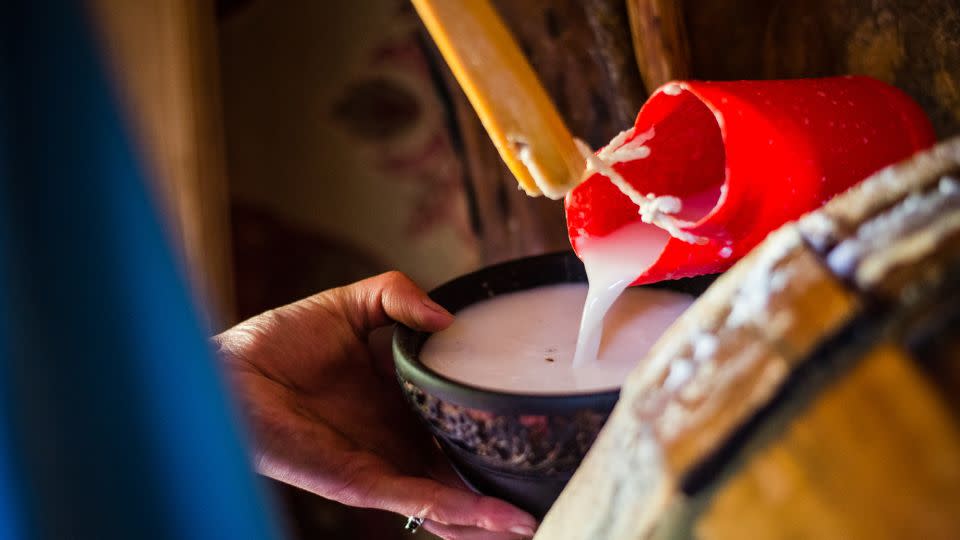
The national “beer” of Mongolia, airag is fermented mare’s milk.
This sour and pungent fizzy beverage is a popular welcome drink in Mongolia. Depending on the amount of time it is fermented, taste, smell, fizziness and alcohol levels vary greatly.
Paired with khuushuur, airag is a popular Naadam Festival drink.
For more CNN news and newsletters create an account at CNN.com

